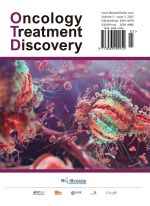Abstract
Objective: To investigate the impact of skin dose on post-mastectomy radiotherapy planning for breast cancer. Methods: Sixty patients undergoing radiotherapy after radical mastectomy for breast cancer were collected as research subjects and divided into a traditional group P1 and a newly designed group P2. The traditional method and a new method with the skin as an organ at risk (OAR) for dose limitation were used to set up the plans. The differences between the radiotherapy plans of the two groups were compared. All patients were followed up, focusing on the occurrence of acute skin reactions ≥ grade 2, to analyze whether limiting skin dose ultimately benefits patients. Results: According to Tables 1, 2, and 3, there was no significant increase in the target dose and the irradiated dose to organs at risk (P > 0.05). Table 4 shows that the maximum skin dose decreased by 1.95%, V107% and V110% decreased by 57.32% and 73.68%, respectively, with statistically significant differences (P < 0.05). Table 5 reveals that among patients without skin dose limitation, 7 developed acute skin reactions ≥ grade 2, whereas only 3 developed such reactions after limitation. Although the incidence of acute skin reactions ≥ grade 2 decreased by 13.33%, the statistical results showed no significant difference (P > 0.05). Conclusion: Limiting skin dose by considering it an organ at risk can significantly reduce the irradiated skin dose. However, reducing the skin dose in breast cancer patients does not significantly decrease the incidence of acute skin reactions ≥ grade 2. This suggests that reducing the skin dose in breast cancer patients does not significantly benefit them.
References
Siegel R, Miller K, Jemal A, 2020, Cancer Statistics, 2020. CA Cancer J Clin, 70(1): 7–30.
Clarke M, Collins R, Darby S, et al., 2005, Effects of Radiotherapy and Differences in the Extent of Surgery for Early Breast Cancer on Local Recurrence and 15-Year Survival: An Overview of the Randomised Trials. Lancet, 366(9503): 2087–2106.
Yang J, 2021, Evaluation of the Application Effect and Safety of Intensity-Modulated Radiotherapy in Adjuvant Therapy After Radical Mastectomy. Practical Gynecologic Endocrinology Electronic Journal, 8(16): 21–23.
Meattini I, Guenzi M, Fozza A, et al., 2017, Overview on Cardiac, Pulmonary and Cutaneous Toxicity in Patients Treated with Adjuvant Radiotherapy for Breast Cancer. Breast Cancer, 24(1): 52–62.
Aoulad N, Massabeau C, de Lafontan B, et al., 2017, Acute Toxicity of Breast Cancer Irradiation with Modulated Intensity by Tomotherapy®. Cancer Radiother, 21(3): 180–189.
Zhang Y, Liao X, Li J, et al., 2017, Dosimetry Study on Neck Skin Exposure in Spiral Tomography for Early Nasopharyngeal Carcinoma. Chinese Journal of Radiological Medicine and Protection, 37(12): 906–910.
Zhang X, Li K, Li N, et al., 2016, Comparison of Skin Exposure Doses Caused by Different External Irradiation Techniques After Breast-Conserving Surgery for Left Breast Cancer. Modern Oncology, 24(20): 3213–3216.
Zhang Y, Liao X, Li J, et al., 2018, Study on the Difference of Set Limit Dose of Neck Skin in Three Radiotherapy Techniques for Early Nasopharyngeal Carcinoma. Chinese Journal of Radiation Oncology, 27(2): 199–203.
Chavaudra J, Bridier A, 2001, Definition of Volumes in External Radiotherapy: ICRU Reports 50 and 62. Cancer Radiother, 5(5): 472–478.
National Cancer Center, National Cancer Quality Control Center, 2022, Guidelines for Target Delineation and Plan Design in Post-Mastectomy Radiotherapy for Breast Cancer. Chinese Journal of Radiation Oncology, 31(10): 863–878.
Huang C, Hou M, Luo K, et al., 2015, RTOG, CTCAE and WHO Criteria for Acute Radiation Dermatitis Correlate with Cutaneous Blood Flow Measurements. Breast, 24(3): 230–236.
Lyu M, Pan X, Wang H, et al., 2019, The Impact of Changes in Circulating Tumor Cell Count on Treatment Efficacy and Prognosis in Patients with HER2-Positive Early Breast Cancer. Oncology Progress, 17(14): 1659–1663.
Drooger J, Akdeniz D, Pignol J, et al., 2015, Adjuvant Radiotherapy for Primary Breast Cancer in BRCA1 and BRCA2 Mutation Carriers and Risk of Contralateral Breast Cancer with Special Attention to Patients Irradiated at Younger Age. Breast Cancer Res Treat, 154(1): 171–180.
Xiao Y, Song L, Fu Y, et al., 2020, Efficacy Analysis of Postoperative Radiotherapy After Modified Radical Mastectomy in Breast Cancer Patients Downstaged by Neoadjuvant Chemotherapy. Chinese and Foreign Medical Research, 39(4): 25–28.
McQuestion M, 2011, Evidence-Based Skin Care Management in Radiation Therapy: Clinical Update. Semin Oncol Nurs, 27(2): e1–17.
Zhuang J, Zhang E, Wang Y, et al., 2020, Recombinant Human Epidermal Growth Factor for the Prevention of Oral Mucositis in Nasopharyngeal Carcinoma Patients Undergoing Concurrent Chemoradiotherapy and Its Effect on Clinical Efficacy. Journal of Navy Medicine, 41(1): 50–53.
Suh O, Flórez M, Sacristán V, et al., Constenla Figueiras M, Pereiro Ferreiros M, 2020, Cutaneous Adverse Events and Quality of Life in Outpatients Receiving Anticancer Agents: Results from an Observational, Cross-Sectional Study. Drugs Context, 9: 2020-6-6.
Wu S, 2020, Study on the Differences in Setting Limit Doses for Neck Skin of Early Nasopharyngeal Carcinoma with Three Radiotherapy Techniques. Modern Diagnosis and Treatment, 31(19): 3123–3124.
Wu Z, Hou L, Li C, et al., 2024, Hypofractionated Versus Conventional Postmastectomy Irradiation for Breast Cancer: Comparison of Acute Skin Toxicity. Breast Cancer (Dove Med Press), 16: 423–432.
